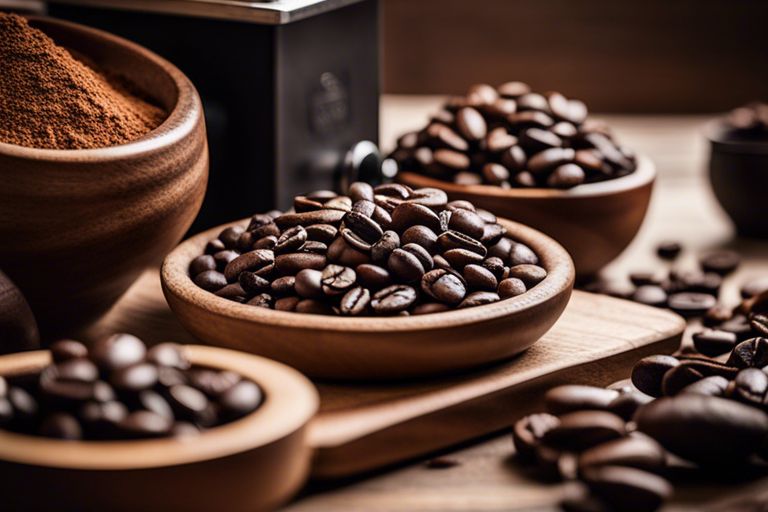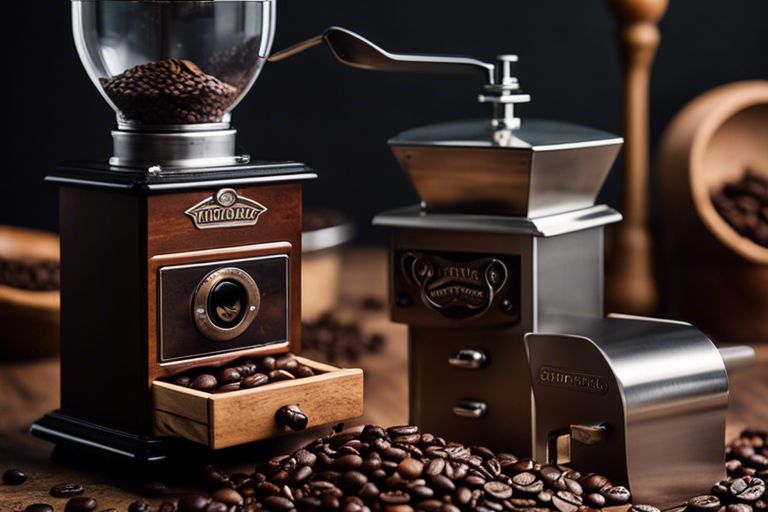You, the coffee enthusiast, must understand the importance of grind size in the pursuit of the perfect cup. From coarse to fine, each grind size affects the flavor and extraction of your beloved brew. Let’s probe into the varying grind sizes and their impact on your morning ritual. Bear in mind, precision in grind size is key to unlocking the true essence of your coffee beans.
Key Takeaways:
- Grind size affects coffee flavor: The size of the coffee grounds impacts the flavor and strength of your brew. Finer grounds extract more quickly, resulting in a stronger taste, while coarser grounds require longer extraction time and produce a lighter flavor.
- Common grind sizes and their uses: Different brew methods require specific grind sizes. For example, French press coffee calls for a coarse grind, while espresso demands a fine grind. Understanding the appropriate grind size for your brewing method will help you achieve the best results.
- Consistency is key: Consistent grind size is crucial for a uniform extraction process. Investing in a quality grinder and adjusting the settings based on your brewing method will ensure a consistent grind size, leading to a balanced and flavorful cup of coffee.

The Importance of Coffee Grind Size
Flavor Profile
An important aspect of coffee brewing is the grind size, as it directly impacts the flavor profile of your brew. Whether you prefer a rich, bold flavor or a lighter, more delicate taste, the grind size plays a crucial role in achieving the desired outcome.
Brewing Methods
For those who savor the art of coffee making, understanding the relationship between grind size and brewing methods is necessary. Different brewing methods, such as espresso, French press, or pour-over, require specific grind sizes to extract the optimal flavors from the coffee beans. Adjusting the grind size to match your brewing method can make all the difference in the taste and quality of your coffee.
Flavor extraction is directly influenced by the grind size used in the brewing process. A finer grind size exposes more surface area of the coffee grounds to the water, resulting in a quicker extraction and often a richer flavor profile. On the other hand, a coarser grind size allows for a slower extraction process, which can lead to a lighter and more nuanced flavor profile. Experimenting with different grind sizes can help you discover the perfect balance of flavors for your palate.
Coarse Grinds
Even though coarse grinds may seem like the black sheep of the coffee grind family, they play a crucial role in certain brewing methods.
French Press
French Press coffee requires a coarse grind to prevent over-extraction that can lead to a bitter brew. The coarse grounds allow for a slower extraction process, resulting in a rich and full-bodied cup of coffee. This grind size is similar to breadcrumbs, providing the perfect texture for the French Press plunge.
Percolator
An important brewing method that often gets overlooked is the trusty Percolator, which also benefits from a coarse grind. The larger particles prevent clogging the Percolator’s filter and ensure a smooth and robust coffee flavor with each brew.
With a Percolator, the coarse grind allows the water to flow evenly through the grounds, creating a consistently delicious pot of coffee. This method may take a bit longer than others, but the end result is well worth the wait.
Cold Brew
One of the trendiest brewing methods is Cold Brew, and it requires a coarse grind to achieve the perfect extraction. Coarse grounds steeped in cold water for an extended period produce a smooth, low-acidic coffee concentrate that is ideal for iced coffee drinks.
Press out the coarse grounds after steeping for 12-24 hours to reveal a flavorful and refreshing Cold Brew that can be enjoyed over ice or mixed with your favorite additives. The coarse grind ensures that the final product is not over-extracted, delivering a well-balanced and satisfying coffee experience.

Medium Grinds
Many coffee lovers prefer medium grinds for their daily brew. This versatile grind size works well with various brewing methods, offering a balanced flavor profile that suits most palates.
Drip Brewer
Any standard drip coffee maker is designed to work best with medium grinds. This grind size allows water to flow evenly through the grounds, ensuring a consistent extraction and a smooth, flavorful cup of coffee.
Pour-over
The pour-over method is highly popular among coffee aficionados who appreciate the art of brewing. The medium grind size is ideal for pour-over devices like the V60 or Kalita Wave, as it allows for a controlled and even extraction of the coffee grounds.
The pour-over method requires a steady hand and a precise pouring technique to achieve the desired flavor profile. The medium grind size helps maintain the balance between extraction and flavor, producing a clean and vibrant cup of coffee.
Chemex
Pourover devices like the Chemex also work exceptionally well with medium grinds. The thicker filter of the Chemex allows for a slower extraction process, which is perfectly complemented by the medium grind size.
With a Chemex, the medium grind size produces a rich and clean cup of coffee with bright acidity and a smooth finish. This brewing method highlights the nuances of the coffee beans, making it a favorite among those who appreciate clarity of flavor.
Another popular choice for medium grinds is the French Press, which requires a coarser grind to withstand the longer extraction time.
Fine Grinds
Espresso
With espresso, the fine grind is crucial for its preparation. This grind is almost powder-like in consistency, allowing for a quick extraction process under high pressure. The fine grind ensures that the water passes through the grounds quickly, resulting in a concentrated shot of rich and flavorful coffee.
Turkish Coffee
Grinds for Turkish coffee are even finer than those for espresso, nearly resembling a talcum powder consistency. This fine grind is imperative for Turkish coffee as it allows for a unique brewing method where the grounds are boiled in water, resulting in a strong and intensely flavored coffee with a thick and frothy texture.
To achieve the perfect Turkish coffee, the fine grind is a must as it enables a maximum extraction of flavor and aroma during the brewing process. This traditional method dates back centuries and is still cherished for its strong and bold coffee taste.
Moka Pot
For Moka pot brewing, a fine grind is necessary to achieve optimal results. The fine grind allows for the right level of extraction when using this stovetop coffee maker. It helps create a balanced and flavorful coffee that sits between the intensity of espresso and the smoothness of drip coffee.
When using a Moka pot, be sure to grind your coffee beans to a fine consistency to ensure proper extraction and a delicious, full-bodied cup of coffee.
Extra-Fine Grinds
Now, when it comes to extra-fine grinds, precision is key. These tiny coffee grounds are almost powder-like in consistency, perfect for certain brewing methods that require a very fine grind. If you’re unsure about the right grind size for your brew, refer to the Coffee Grind Chart- Which Grind for Different Coffee Makers to find the perfect match.
Stovetop Espresso
Stovetop espresso makers, also known as Moka pots, thrive on extra-fine grinds. This grind size is vital for achieving that strong and rich espresso flavor characteristic of this brewing method. The fine grind allows for optimal extraction during the stovetop brewing process, producing a delicious and intense cup of coffee.
Aeropress
For Aeropress aficionados, an extra-fine grind is the way to go. This brewing method benefits from the ultra-fine grounds by allowing for a quick and efficient extraction. The result is a smooth and bold cup of coffee that will satisfy even the most discerning coffee lover.
To enhance the flavors and aromas extracted during the Aeropress brewing process, a consistent and fine grind is crucial. Experiment with different coffee beans and grind sizes to find the perfect combination that suits your taste preferences.
Common Mistakes to Avoid
Incorrect Grind Size
One common mistake to avoid when grinding coffee is using the incorrect grind size for your brewing method. Each brewing method requires a specific grind size to achieve the optimal flavor. Using a grind that is too coarse or too fine can result in over-extraction or under-extraction, leading to a bitter or weak cup of coffee.
Inconsistent Grind
Size inconsistency in your coffee grind can also impact the flavor of your brew. When there is a mix of coarse and fine particles in the grind, it can lead to uneven extraction during brewing. This can result in a cup of coffee that lacks balance and complexity, with certain notes overpowering others.
With inconsistent grind size, some particles may be under-extracted while others are over-extracted, creating a muddled and unappealing taste. To avoid this, ensure that your coffee grinder is set to a uniform grind size and that you grind the beans evenly for each batch of coffee you brew.
Summing up
As a final point, understanding the different coffee grind sizes is crucial for brewing the perfect cup of coffee. Whether you are using a French press, pour-over, or espresso machine, the grind size plays a crucial role in determining the taste and quality of your coffee. From extra coarse to extra fine, each grind size has a specific purpose and is suited for different brewing methods.
By mastering the art of grinding coffee to the correct size, you can elevate your coffee experience and enjoy a fresh and flavorful cup every time. Experimenting with different grind sizes and brewing methods will help you discover your favorite flavor profiles and brewing techniques, allowing you to tailor your coffee to suit your preferences perfectly.
FAQ
Q: What is a Coarse Grind in Coffee?
A: A coarse grind in coffee is characterized by large particles that have a similar consistency to kosher salt. This type of grind is ideal for brewing methods such as French press and cold brew.
Q: What is a Medium Grind in Coffee?
A: A medium grind in coffee falls somewhere between a coarse and fine grind. It is commonly used in drip coffee makers and pour-over devices.
Q: What is a Fine Grind in Coffee?
A: A fine grind in coffee has smaller particles, similar to table salt or sand. This grind size is perfect for espresso machines and moka pots.
Q: What is an Extra Fine Grind in Coffee?
A: An extra fine grind in coffee is even finer than a fine grind, with particles comparable to powdered sugar. This grind size is typically used in Turkish coffee preparation.
Q: Why is it important to use the right grind size for coffee?
A: Using the correct grind size for your brewing method is crucial for achieving the best flavor extraction. Different grind sizes result in variations in extraction time and surface area, affecting the taste and strength of your coffee.





